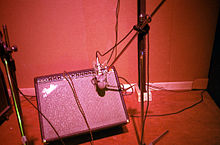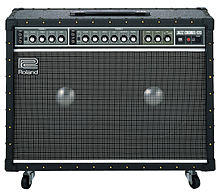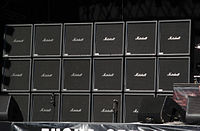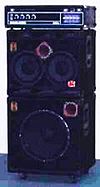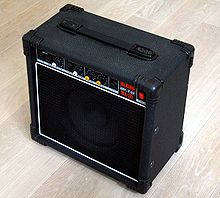- Instrument amplifier
-
This page is about amplifiers for musical instruments. See also instrumentation amplifier, a type of operational amplifier.
An instrument amplifier is an electronic amplifier that converts the often barely audible or purely electronic signal from musical instruments such as an electric guitar, an electric bass, or an electric keyboard into an electronic signal capable of driving a loudspeaker that can be heard by the performers and audience. Combination ("combo") amplifiers include a preamplifier, a power amplifier, tone controls, and one or more speakers in a cabinet, a housing usually made of hardwood, plywood, particleboard, or, less commonly, moulded plastic. Instrument amplifiers for some instruments are also available without an internal speaker; these amplifiers have to be plugged into an external speaker cabinet.
Instrument amplifiers are available for specific instruments, including the electric guitar, electric bass, electric keyboards, and acoustic instruments such as the mandolin and banjo. Some amplifiers are designed for specific styles of music, such as the "traditional"-style "tweed" guitar amplifiers used by blues and country musicians, and the Marshall amplifiers used by hard rock and heavy metal bands.
Unlike home "hi-fi" amplifiers or public address systems, which are designed to reproduce accurately the source sound signals with as little harmonic distortion as possible, instrument amplifiers are often designed to add additional tonal coloration to the original signal or emphasize (or de-emphasize) certain frequencies. The two exceptions are keyboard amplifiers and "acoustic" instrument amplifiers, which typically aim for a relatively flat frequency response.
Contents
Types
Guitar amplifiers
Standard amps
Standard amplifiers, such as the Fender "tweed"-style amps and Gibson amps, are often used by traditional rock, blues, and country musicians who wish to create a "vintage" 1950s-style sound. They are used by electric guitarists, pedal steel guitar players, and blues harmonica ("harp") players. Combo amplifiers such as the Fender Super Reverb have tube amplifiers, four 10" speakers, and built-in reverb and "vibrato" effects units.
These amps are designed to produce a variety of sounds ranging from a clean, warm sound (when used in country and soft rock) to a growling, natural overdrive, when the volume is set near its maximum, (when used for blues, rockabilly, and roots rock). These amplifiers usually have a sharp treble roll-off at 5 kHz to reduce the extreme high frequencies, and a bass roll-off at 60–100 Hz to reduce boominess. The nickname "tweed" refers to the lacquered beige-light brown fabric covering used on these amplifiers.
The smallest "combo" amplifiers, which are mainly used for rehearsal and warm-up purposes, may have only a single 8" or 10" speaker. Some harmonica players use these small combo amplifiers for concert performances, though, because it is easier to create natural overdrive with these lower-powered amplifiers. Larger combo amplifiers, with one 12 inch speaker or two or four 10 or 12 inch speakers are used for club performances. For large concert venues, performers may also use an amplifier "head" with several separate speaker cabinets (which usually contain two or four 12" speakers).
Hard rock and heavy metal
These electric guitar amplifiers add an aggressive "drive", intensity, and "edge" to the guitar sound with distortion effects, preamplification boost controls, and tone filters. While many of the most expensive, high-end models use tube amplifiers, there are also many models that use transistor amplifiers, or a mixture of the two technologies (i.e., a tube preamplifier with a transistor power amplifier).
Amplifiers of this type, such as Marshall amplifiers, are used in a range of the louder, heavier genres of rock, including hard rock, heavy metal, and hardcore punk. This type of amplifier is available in a range of formats, ranging from smaller combo amplifiers for rehearsal and warm-up purposes to heavy "heads" which are designed to be used with separate speaker cabinets, which is colloquially referred to as a "stack." In the late 1960s and early 1970s, public address systems at rock concerts were used mainly for the vocals. As a result, to get a loud electric guitar sound, early heavy metal and rock-blues bands often used "stacks" of 4x12" Marshall speaker cabinets on the stage. In 1969 Jimi Hendrix used four stacks to create a powerful lead sound, and in the early 1970s by the band Blue Öyster Cult used an entire wall of Marshall Amplifiers to create a roaring wall of sound. In the 1980s, metal bands such as Slayer and Yngwie Malmsteen also used "walls" of over 20 Marshall cabinets. However, by the 1980s and 1990s, most of the sound at live concerts was produced by the sound reinforcement system rather than the onstage guitar amplifiers, so most of these cabinets were not connected to an amplifier. Instead, walls of speaker cabinets were used for aesthetic reasons.
Amplifiers for harder, heavier genres often use valve amplifiers (known as "tube amplifiers" in North America) also. Valve amplifiers have a "warmer" tone than those of transistor amps, particularly when overdriven. Instead of abruptly clipping off the signal at cut-off and saturation levels, the signal is rounded off more smoothly. Vacuum tubes also exhibit different harmonic effects than transistors. In contrast to the "tweed"-style amplifiers, which use speakers in an open-backed cabinet, companies such as Marshall tend to use 12" speakers in a closed-back cabinet. These amplifiers usually allow users to switch between "clean" and distorted tones (or a rhythm guitar-style "crunch" tone and a sustained "lead" tone) with a foot-operated switch.
Bass
Main article: Bass amplifierBass amplifiers are designed for bass guitars or more rarely, for upright bass. They differ from amplifiers for the regular electric guitar in several respects. They have extended bass response and tone controls optimised for bass instruments, which produce pitches of 40 Hz, in the case of a standard four-string electric bass, or even lower for five- or six-string electric basses.
Higher-end bass amplifiers sometimes include compressor or limiter features, which help to keep the amplifier from distorting at high volume levels, and an XLR DI output for patching the bass signal directly into a mixing board or PA systems. Larger, more powerful bass amplifiers (300 or more watts) are often provided with external metal heat sinks or fans to help keep the amplifier cool.
Speaker cabinets designed for bass instrument amplification usually use larger loudspeakers (or more loudspeakers, in the case of the popular 4 X 10" cabinets, which contain four 10" speakers) than the cabinets used for other instruments, so that they can move the larger amounts of air needed to reproduce low frequencies. While the largest speakers commonly used for regular electric guitar are 12" speakers, electric bass speaker cabinets often use 15" speakers. Bass players who play styles of music that require an extended low-range response, such as death metal, sometimes use speaker cabinets with 18" speakers.
The speakers used for bass instrument amplification tend to be more heavy-duty than speakers used for regular electric guitar, and the speaker cabinets are typically more rigidly constructed and heavily braced, to prevent unwanted buzzes and rattles. Bass cabinets often include bass reflex ports or openings in the cabinet, which improve the bass response, especially at high volumes.
Keyboard
This type of amplifier is used to amplify a range of electric and electronic keyboards, such as synthesizers, Hammond organ-style keyboards, stage pianos and electric pianos. Since keyboard instruments contain a wide frequency range, from very low bass notes to extremely high pitches, keyboard amplifiers are often provided with a large woofer speaker to handle the low notes and a horn (or tweeter) for the high notes.
Keyboard amplifiers intended for general use for a range of keyboard applications usually have very low distortion and extended, flat frequency response in both directions. The exception to this rule is keyboard amplifiers designed for the Hammond organ, such as the vintage Leslie speaker cabinet and modern recreations, which have a tube amplifier which is often turned up to add a warm, "growling" overdrive to the organ sound.
Unlike bass amplifiers and electric guitar amplifiers, keyboard amplifers are rarely used in the "amplifier head" and separate speaker cabinets configuration. Instead, most keyboard amplifiers are "combo" amplifiers that integrate the amplifier, tone controls, and speaker into a single wooden cabinet. Another unusual aspect of keyboard amplifiers is that they are often designed with a "wedge" shape, as used with monitor speakers. This allows the cabinet to be rocked back so that it will project sound upwards at a roughly 45' angle, which is more suitable for a seated keyboardist.
Keyboard amplifiers often have a simple onboard mixer with multiple inputs, so that keyboardists can control the tone and level of several keyboards. In some genres, such as progressive rock, for example, keyboardists may perform with several synthesizers, electric pianos, and electro-mechanical keyboards.
Acoustic
These amplifiers are designed to be used with acoustic instruments such as violin ("fiddle"), mandolin, and acoustic guitar, especially for the way these instruments are used in relatively quiet genres such as folk and bluegrass. They are similar in many ways to keyboard amplifiers, in that they have a relatively flat frequency response, and they are usually designed so that neither the power amplifier nor the speakers will introduce additional coloration.
To produce this relatively "clean" sound, these amplifiers often have very powerful amplifiers (providing up to 800 watts RMS), to provide additional "headroom" and prevent unwanted distortion. Since an 800 watt amplifier built with standard Class AB technology would be very heavy, some acoustic amplifier manufacturers use lightweight Class D amplifiers, which are also called "switching amplifiers."
Acoustic amplifiers are designed to produce a "clean", transparent, "acoustic" sound when used with acoustic instruments with built-in transducer pickups and/or microphones. The amplifiers often come with a simple mixer, so that the signals from a pickup and microphone can be blended. Since the early 2000s, it has become increasingly common for acoustic amplifiers to be provided with a range of digital effects, such as reverb and compression. As well, these amplifiers often contain feedback-suppressing devices, such as notch filters or parametric equalizers. [1]
Roles
Instrument amplifiers are designed for a different purpose than 'Hi-Fi' (high fidelity) stereo amplifiers used for radios and home stereo systems. Hi-fi home stereo amplifiers are designed to accurately reproduce the source sound signals from pre-recorded music, with as little harmonic distortion as possible. In contrast, instrument amplifiers are often designed to add additional tonal coloration to the original signal or emphasize certain frequencies. For electric instruments such as electric guitar, the amplifier helps to create the instrument's tone by boosting the input signal gain and distorting the signal, and by emphasizing frequencies deemed to be desirable (e.g., low frequencies) and de-emphasizing frequencies deemed to be undesirable (e.g., very high frequencies).
The two exceptions are keyboard amplifiers and acoustic amplifiers which are used by folk and bluegrass musicians for amplifying acoustic instruments such as acoustic guitar, violin, and mandolin. Acoustic amplifiers typically aim for a relatively flat response across the entire frequency range, much like a Public Address system.
Size and power rating
In the 1960s and 1970s, large, heavy, high output power amplifiers were preferred for instrument amplifiers, especially for large concerts, because public address systems were generally only used to amplify the vocals. Moreover, in the 1960s, PA systems typically did not use monitor speaker systems to amplify the music for the onstage musicians. Instead, the musicians were expected to have instrument amplifiers that were powerful enough to provide amplification for the stage and audience. In late 1960s and early 1970s rock concerts, bands often used large stacks of speaker cabinets powered by heavy tube amplifiers such as the Super Valve Technology (SVT) amplifier, which was often used with eight 10" speakers.
However, over subsequent decades, PA systems were substantially improved, and different approaches such as horn-loaded "bass bins" (in the 1980s) and subwoofers (1990s and 2000s) were used to amplify bass frequencies. As well, in the 1980s and 1990s, monitor systems were substantially improved, which allowed sound engineers to provide onstage musicians with a loud, clear, and full-range reproduction of their instruments' sound.
As a result of the improvements to PA systems and monitor systems, musicians in the 2000s no longer need to have huge, powerful amplifier systems; a small combo amplifier patched into the PA will suffice. In the 2000s, virtually all of the sound reaching the audience in large venues comes from the PA system. As well, in the 2000s onstage instrument amplifiers are more likely to be kept at a low volume, because high volume levels onstage makes it harder to control the sound mix and produce a clean sound.
As a result, in many large venues much of the onstage sound reaching the musicians now comes from the monitor speakers, not from the instrument amplifiers. While stacks of huge speaker cabinets and amplifiers are still used in concerts (especially in heavy metal), this is often mainly for aesthetics or to create a more authentic tone. The switch to smaller instrument amplifiers makes it easier for musicians to transport their equipment to performances. As well, it makes concert stage management easier at large clubs and festivals where several bands are performing in sequence, because the bands can be moved on and off the stage more quickly.
Amplifier technology
Instrument amplifiers may be based on thermionic ("tube" or "valve") or solid state (transistor) technology.
Tube Amplifiers
Vacuum tubes were the dominant active electronic components in amplifiers manufactured from the 1930s through the early 1970s, and tube amplifiers continue to be preferred by some professional musicians. Some musicians believe that tube amplifiers produce a "warmer" or more "natural" sound than solid state units. However, these subjective assessments of the attributes of tube amplifiers' sound qualities are the subject of ongoing debate.
Although tube amplifiers produce more heat than solid state amplifiers, few manufacturers of these units include cooling fans in the chassis. While tube amplifiers do need to attain a proper operating temperature, if the temperature goes above this operating temperature, it may shorten the tubes' lifespan and lead to tonal inconsistencies. [2]
 A Trace Elliot "Bonneville" tube amplifier as seen from the rear view: note the vacuum tubes extending into the wooden cabinet.
A Trace Elliot "Bonneville" tube amplifier as seen from the rear view: note the vacuum tubes extending into the wooden cabinet.
Solid-state Amplifiers
By the 1960s and 1970s, semiconductor transistor-based amplifiers began to become more popular because they are less expensive, lighter-weight, and require less maintenance. In some cases, tube and solid-state technologies are used together in amplifiers. A common setup is the use of a tube preamplifier with a solid-state power amplifier. There are also an increasing range of products that use digital signal processing and digital modeling technology to simulate many different combinations of amp and cabinets.
The output transistors of solid-state amplifiers can be passively cooled by using metal fins called heatsinks to radiate away the heat. For high-wattage amplifiers (over 800 watts), a fan is often used to move air across internal heatsinks.[3]
See also
- Amplifier
- Electronic amplifier
- Guitar amplifier
- Guitar speaker
- Guitar speaker cabinet
- Isolation cabinet (guitar)
- Valve sound
- Bass instrument amplification
- Effects unit
- Distortion (guitar)
- Power attenuator (guitar)
- Sound reinforcement system
References
- ^ Note: This style of amplifiers should not be confused with the brand of guitar and bass amplifiers called Acoustic, still available in second-hand music stores.)
- ^ Cool it, man; Michael "Mac" McCullough.
- ^ Power Amplifiers - General Information: Yorkville Sound
External links
- Duncan's amp pages - all sorts of information, especially, but not only, on valve guitar amplifiers
- List of books about guitar amplifiers and guitar amplifier tone
- Tons of Tones !! : Technical site for Guitar Amplifier Modelling on Digital Multi-effect units
Categories:- Instrument amplifiers
Wikimedia Foundation. 2010.

